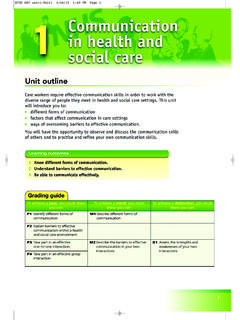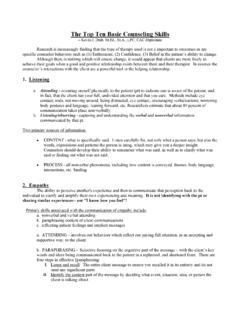Transcription of 1 Communication in health and social care - Collins Education
1 Communication 1 in health and social care Unit outline Care workers require effective Communication skills in order to work with the diverse range of people they meet in health and social care settings. This unit will introduce you to: different forms of Communication factors that affect Communication in care settings ways of overcoming barriers to effective Communication . You will have the opportunity to observe and discuss the Communication skills of others and to practise and refine your own Communication skills. Learning outcomes 1 Know different forms of Communication . 2 Understand barriers to effective Communication . 3 Be able to communicate effectively. Grading guide To achieve a pass, you must show To achieve a merit, you must To achieve a distinction, you must you can: show you can: show you can: P1 Identify different forms of M1 Describe different forms of Communication Communication P2 Explain barriers to effective Communication within a health and social care environment P3 Take part in an effective M2 Describe the barriers to effective D1 Assess the strengths and one-to-one interaction Communication in your two weaknesses of your two interactions interactions P4 Take part in an effective group interaction 1.
2 Topic Forms of Communication Getting started This topic introduces you to the forms of Communication used by health and social care workers and the contexts in which they are used. When you have completed this topic, you should: be able to describe and explain the Communication cycle know about one-to-one, group, formal and informal Communication in health and social care settings be able to describe a range of different forms of Communication used by health and social care workers. Key terms Decode: make sense of the information contained hand signs, which is used by people with language and in a message learning difficulties Empathy: understanding and entering into another Non-verbal Communication : forms of Communication person's feelings that do not use words ( body language).
3 Formal Communication : official or correct forms of Objects of reference: objects that have a particular Communication meaning for a person ( a special ring or ornament). Informal Communication : doesn't stick to the formal Symbol: an item or image that is used to represent rules of Communication ( a casual, relaxed something else conversation, written note or text message) Verbal Communication : forms of Communication that Makaton: a system of Communication using simple use words ( conversation). The Communication cycle Communication is about making contact with others and being understood. It involves people sending and receiving messages'. 2. We all communicate, or send messages', continuously. Figure Message describes the Communication cycle. It shows that a Communication coded cycle occurs when: 1 Idea Message 3.
4 Occurs sent 1. A person has an idea. 2. They code their message' (using words or non-verbal means). 3. They send their message to someone else ( by speaking). Message Message 6 understood 4. 4. A second person then receives the message ( by hearing received Message what has been said or by noticing non-verbal Communication ). decoded 5. The second person decodes the message. 5. 6. The message is understood. Figure The Communication cycle 2. 1 Communication in health and social care Once the original message has been understood, the cycle will be repeated if the second person replies or responds. Repetitions of the Communication cycle are an essential part of our relationships, and occur every time we have a conversation. Case study Charlie is 2 years of age.
5 He enjoys helping 1. How does Charlie's mum communicate with his mum in the kitchen when she is making him in this example? a meal. When she says, Can I get some fruit 2. How does Charlie communicate non-verbally for you Charlie?', he puts his arms in the air, with his mum in response to her question? says me, me' and smiles at her. His mum responds by picking him up and saying, 3. Describe how a cycle of Communication Okay, you take something yourself this occurs in this example. time, Charlie'. Forms of Communication Care workers use different forms of Communication during their working day (or night). These include the verbal Communication skills of talking and listening, and various forms of non-verbal Communication , such as touch, eye contact and facial expression.
6 A care worker has to use both of these forms of Communication when they: give or receive information about the care that is being provided for an individual provide emotional support to a individual or member of their family carry out an assessment of an individual's care needs. Verbal Communication Verbal Communication occurs when one person speaks and another person listens. Care workers need a range of verbal Communication skills to: respond to questions find out about an individual's problems or needs contribute to team meetings break bad news provide support to others Over to you! deal with problems and complaints. Are you a good listener? Think about The Communication cycle demonstrates that effective verbal what you do when you really listen Communication is a two-way process speaking and to another person.
7 Try to identify listening must occur. Listening is much harder than speaking and the skills and qualities needed for there is more to this skill than just waiting for the other person to effective listening. stop talking. 3. Forms of Communication Non-verbal Communication As well as communicating through speech, people use a variety of forms of non-verbal Communication . Some of these are referred to as body language. This is because they involve the individual using their body and appearance to communicate in some way. For example, a care worker's behaviour, appearance and attitude send messages' to people who receive care (as well as to colleagues). about what they think and feel. Similarly, a person's body language may tell a care worker that they are uncomfortable or experiencing pain even when they say, I'm okay'.
8 Non-verbal Communication is a channel of Communication that is always on'. Figure Forms of non-verbal Communication Non-verbal What does it involve? Examples Communication Facial expression Movements of the face that Smiling express a person's feelings Frowning Touch or contact Physically touching or holding Holding someone's hand a person Placing a hand on a person's arm or shoulder to reassure them Gestures Deliberate movements of the Thumbs-up gesture to show agreement or pleasure hands to express meaning Shaking a fist to show anger or aggression Proximity The physical closeness Being physically close to someone may be reassuring and may be between people during seen as accepting the person. interactions On the other hand, it might make the person feel uncomfortable and threatened.
9 People need less personal space when they have a close, trusting relationship. Eye contact Looking another person Short or broken eye contact can express nervousness, shyness directly in the eyes or mistrust. Long unbroken eye contact can express interest, attraction or hostility. Signs, symbols and objects of reference Care organisations sometimes use signs and symbols to communicate Over to you! with the people who use their premises. Signs and symbols are When you have a chance, watch a graphical ways of communicating essential information. Using images group of people talking or socialising enables people who cannot speak or understand a spoken language, together. Observe the way they use such as English, to communicate. their bodies to communicate. Try Objects of reference are items such as toys, clothes, jewellery or to work out what they are saying'.
10 Other everyday objects that have a special meaning for somebody. For a non-verbally. child, a cuddly toy may represent comfort and safety. An older person may treasure their photographs because they represent and provide memories of family, friends and relatives. Objects of reference, such as photos or toys might be used by a teacher to stimulate Communication and interaction with individuals with learning disabilities. 4. 1 Communication in health and social care Technological aids Technological aids, such as electronic communicators, hearing aids and videophones are designed to help disabled people who have difficulty sending or receiving messages' as part of the Communication cycle. Many non-disabled people now also use technology in the form of mobile phones, text messaging and emails to communicate with others.















